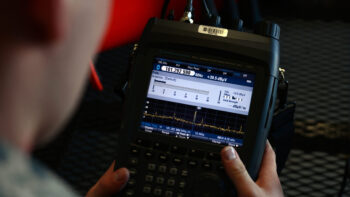
Shown is a payload assembly on the Slingshot CubeSat platform, which was used for the Aerospace demonstration of on-orbit spacecraft cyber defense. Photo courtesy of Aerospace.
Space-based communications, navigation, weather, and remote sensing capabilities from the commercial sector play a large role in successfully executing Department of Defense (DOD) missions. To that end, The Aerospace Corporation (Aerospace) plans to launch the Slingshot 1 small satellite in the first quarter of 2022 to prove the feasibility of providing a standard interface for multiple payloads on a single spacecraft flying in low Earth orbit.
In addition to providing access to an on-orbit space test environment, the mission will demonstrate the capability of the SatCat5 Ethernet standard, which would allow developers to employ commercial tools and open-source code from the extensive Ethernet ecosystem.
Last month, Aerospace also announced the launch of its Commercial Space Futures initiative to work with government partners to make sure they can leverage the best the U.S. commercial space industry has to offer to advance U.S. leadership in space. Commercial Space Futures is an extension of the company’s existing support to its customers that will serve as a single touchpoint for commercial-oriented activities.
In this Q&A with Kevin Bell, senior vice president of Aerospace’s Space Systems Group, we discuss the current and future threats that could affect the DOD’s space-based resources, some interesting results from the company’s recent space-industry survey, and how it’s working with the U.S. Space Force and Space Systems Command on integrating commercial and military space capabilities.
Breaking Defense: What are the commercial-satellite capabilities that are most applicable to the DOD? Clearly, we’re not talking about something like GPS, but what is that world of commercial satellites that the DOD would be interested in?

Kevin Bell, senior vice president of Aerospace’s Space Systems Group.
Bell: Well, it really spans most of the DOD mission set. There are some exquisite capabilities that aren’t available yet commercially—such as missile warning and tracking—especially given some of the newer threats that are emerging from our near-peer adversaries.
But outside of that mission area, and maybe outside some of our nuclear command and control infrastructure, most of the other mission areas have at least a commercial layer that will add value to the DOD. The obvious one is SATCOM for broadband communications, though maybe not for protected data transport.
Then there are capabilities like bringing tactical intelligence, surveillance, and reconnaissance data down to combatant commanders. Weather is another obvious one. We collaborate with our foreign allies on all of these systems, but weather is one where we currently close the architecture with our foreign allies, as well as with other parts of the civil sectors of the government.
You mentioned GPS as a dedicated defense mission, but we already have commercial augmentation services for GPS that we’re looking at utilizing from a resiliency standpoint to add another dimension or layer.
There are also other commercial satellite capabilities that may play an even more important role. These would be things like data-backhaul-as-a-service, which could be used with an exquisite satellite to get data off that platform and directly to anyplace in the world. I call it “data backhaul” generically because it could be going through an RF, laser, or other kind of crosslink into a commercial network that can bring that data to anywhere in the world.
Likewise, we’ve also been experimenting with ground-segment-as-a-service, where we’re buying time and data transport on commercial receivers connected to a commercial cloud, as well as buying storage and processing, and then making that data available directly to users. You can imagine that this has great application for missions like weather, where we want to make that data available for analysts to exploit.
Equally important is what the commercial industry brings in cyber operations and defensive needs to harden our networks. In addition, the commercial marketplace is making important advances in the use of artificial intelligence and machine learning. We must track and identify new developments in adjacent sectors, and make sure those breakthroughs are brought into the space sector.
Breaking Defense: The Breaking Defense/The Aerospace Corporation 2021 Military Space Survey had an interesting observation to make on cybersecurity in space. What did the survey say?
Bell: Maybe it’s not surprising, but many respondents thought that cyber will be the greatest challenge to the U.S. national security space enterprise in the next five years.
Integrating commercial systems into military satellite networks with appropriate cybersecurity is going to be an enabling capability for the DOD, and we have to make sure we understand how they fit into the warfighting enterprise. To this end, Aerospace is advancing integrated cybersecurity functions for on-orbit spacecraft, enabling the use of onboard machine learning and signatures to detect and respond to unusual command sequences and other anomalies in a much-reduced time frame.
At present, defensive cyber operations for space rely on telemetry to downlink information from spacecraft to ground operations for data processing, resulting in increased turnaround time. Bringing this functionality onboard the spacecraft not only reduces the turnaround time for cyber-anomaly detection and response, it also increases options for threat mitigation.
Breaking Defense: We recently interviewed DOD SATCOM Chief Mike Dean and he said that a rationale for moving the Defense Department’s commercial Satcom office into Space Command is to better leverage commercial and military Satcom capabilities. So, your comments fit into that strategy.
Bell: Yes, that’s exactly why the DOD brought the Commercial Satellite Communications Office (CSCO) into the Space Systems Command (SSC) and why it’s no longer just SATCOM—it’s now commercial services. It’s extending its scope beyond SATCOM. Even in CSCOs latest request for information (RFI), while still focused on proliferated LEO SATCOM, you’ll notice requests for data backhaul via commercial constellations, as well as commercial services potentially hosting payloads. So, they’re asking industry, “What’s the art of the possible? What would that look like? How would we buy payload hosting as a service?”
Breaking Defense: How else is The Aerospace Corporation working with the DOD to accelerate the role of commercial capabilities in USG space missions.
Bell: We’ve got extensive laboratory capability and some of that is space-effects testing. From that perspective, we’re able to help many small companies bring their products to market on a technology and developmental level. A few examples include components such as optical coatings, electric thrusters, or rocket parts. We’re able to bring small companies in and help them test in facilities that they don’t otherwise have access to. We do that for the benefit of future U.S. government capabilities.
On another level, we offer opportunities to bring commercial technology to a demonstration state and on ramp into the field. In those cases, we’re often hosting payloads either on our own satellites or on other commercial satellites. We’ve built some charged-particle sensors and ultimately transitioned the design of that charged-particle sensor to a contractor who produces those now. We’ve also hosted those on a proliferated-LEO constellation with data backhaul to a network. Similarly, we’ve transferred GPS anti-jam techniques to commercial vendors to create end-user products.
Lastly, we’re working shoulder-to-shoulder with the U.S. Space Force and SSC on a commercial-space-pathways program to develop commercial solutions, which could be services or bringing products into the architecture. A recent example includes using sensor telemetry on larger constellations to map portions of the electromagnetic spectrum useful for military operations.
At the same time, we’re working with Space Systems Command to support the major partnership lines of effort: expanding and strengthening the network of allied, civil, and commercial relationships to increase cooperation, collaboration, and interoperability in the space domain to yield a more resilient space enterprise. These partnerships serve as a force multiplier in several dimensions.























